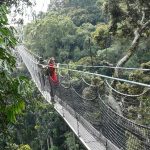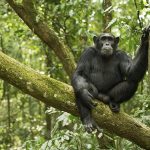Nyungwe Forest National Park is situated inside the Nyungwe Forest. Nyungwe’s area includes several, grasslands, marshes, rainforests, and bogs. The area is rich in biodiversity and is a wonderful sight. And, is regarded as the best-preserved mountainous rainforest in Central Africa.
Best Time to visit Nyungwe National Park
A Nyungwe National Park Safari is available all year round. Yet, the Dry Season (from June to September) is the perfect time for hiking and chimpanzee trekking.
During this season, Rwanda Safari Activities are less likely to be affected by rainfall. Also, the trekking trails are not going to be slippery.
If you’re going to visit Nyungwe National Park in March and April, then bring the proper equipment. Because the trails of the forest are likely to be slippery.
Animals at Nyungwe National Park
Nyungwe National Park has an extensive concentration of species. They include 275 species of birds, 13 primate species, 38 reptile species, and 85 mammal species.
Animals that you’re likely going to see are chimpanzees, sliver, golden, red-tailed monkeys, olive baboons, etc.
Other animals include mongoose, leopard, clawless otter, duiker, elephant, serval, Impala, etc.
Activities to do in Nyungwe National Park
There are many activities available for visitors at Nyungwe National Park. They include guided nature walks, canopy walks, visiting tropical waterfalls, camping, birdwatching, primates trekking, etc.
Highlights of Nyungwe National Park
Below are the top highlights in Nyungwe National Park:
- Has over 100 km. of hiking trails.
- Excellent canopy walks.
- A Birdwatching paradise. With many species native to the Albertine Rift.
- A rich rainforest that has incredible biodiversity.
- Brilliant Rwanda safari destination for chimpanzee trekking.
Thus, make sure to include a Nyungwe National Park Safari in your Rwanda Itinerary. And, you won’t be disappointed!
Nyungwe National Park Location
Rwanda
valid passport or another acceptable travel document
Kinyarwanda, French, Swahili, English
Rwandan Francs
1,019 km²












